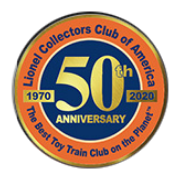Frequently Asked Questions
- ALL
- Train Values and Selling My Trains
- Unique and Valuable Lionel Trains
- Parts and Service for My Trains
- Operating My Trains
- Sizes of Lionel Trains
- Lionel Fastrack Layouts and Operation
- LCCA Fastrack Modules and Standards
- Lionel Customer Programs
- Software - Inventory, Track Planning etc
- Storage Conditions and Packaging of Trains
Lionel Fastrack Layouts and Operation
Just to be sure we’re both talking about the same thing – I am assuming that you have the FasTrack uncoupling section. This is a 5 inch long track with a magnet in the center and a single button to control it (No. 12020). This track should operate any car that has a central plunger that must be pulled down to operate. If the car has sliding shoes on its trucks, then you need the Operating Track (No. 12054). The operating track has a two button controller – one button controls the inner control rails and the other controls the central magnet.
Some work with a central plunger and others work with the sliding shoes. The operating Poultry car uses the central plunger activated by the uncoupling magnet. The poultry car should work with either type of track. Use the uncouple button and the magnet should pull down the plunger under the poultry car. Move the car slightly to check that it is in the best position to be pulled by the magnet. On some cars the tolerance is quite close. If it still does not work, test that the magnet is energizing by holding a screwdriver blade over it when the button is pressed.
The black film you have noticed is quite common. Lionel's recommend using an all-purpose cleaner with a citric base. We recommend a citric based cleaner because it does not degrade the metal rails, nor does it cause poor electrical connectivity between the rails and the wheels of the train. Alcohol-based cleaners should be avoided since they tend to degrade the electrical connectivity of your trains.
I believe this black comes from the wheels of the cars and loco. Most wheels today are made via the powder metallurgy process. On some of the display layouts, the loops are small and the trains run for many hours. On the towers that Lionel has on its largest layout, each has several circles of FasTrack and the trains run constantly on them and always in the same direction. On these, wear of the wheels can clearly be seen. Since the loop has no straight tracks the wear occurs faster and since the train is always going the same direction, the wheels on one side wear much faster. I’ve seen some of the wheels actually get sharp due to this wear.
Any track cleaner that you use, should be wiped off the track before running trains on it. I don’t know how different track cleaners effect the traction tires. Denatured alcohol works well and is quite inexpensive. I don’t think there is any way to prevent this build up if you run your trains. You are doing the right thing by cleaning it off when necessary.
Lionel prewar O gauge will run just fine on FasTrack. Lionel’s prewar Standard Gauge is too large. If you are operating Standard Gauge trains, MTH Trains has a FasTrack look alike in Standard Gauge.
The number part of the radius designation, i.e. 36 for O36, indicates the measurement from the center rail to center rail of a circle made without straights. To figure the actual table space taken up by a particular radius of FasTrack, simply take the number in the designation, and add 3 3/8 inches. So for O36 track, a circle without straights will require 39 3/8 inches of width on the table. For the O60, the width of a circle would be 63 3/8 inches. FasTrack has been designed so that you can space track 6 inches on center apart. So if your inner track is O36, you could run an O48 loop of track 6 inches outside of the O36 loop, and an O60 loop 6 inches from that.
I’ve created a drawing which shows a half circle of O36, O48, and O60. The drawing is to scale and each square of the graph equals 12 inches. The width of each half circle is 39 3/8 inches, 51 3/8 inches and 63 3/8 inches. There is 6 inches from center rail to center rail between each loop.

